The Subjective Craft of mixing is mastered by knowing when to leave the knobs alone. More blood has been spilt by this oversight than all other problems combined. The ability to be excellent in the craft of production arrangement (mixing) is a gift similar to the craft of musical arrangement.
There are hundreds of web sites, books and periodicals with excellent information on mixing and production. This page is not intended to repeat information, but to prioritise the order of information (especially hardware understanding) essential for best practice. This page also challenges many of the inept practices and false beliefs entrenched within the pop recording industry.

The above mixer design evolved from the film and broadcast industry. Note the small monitor speakers on top of the mixing desk. These mixers can be used by many operators as a production team. Each operator managing a different section of the sound track. Editing sync, dialogue, background environments, effects and music.
These large production consoles became used by the pop recording industry from the late 1960s. A large percentage of the pop music industry is image driven and recording studios competed by who had the LARGEST mixing console and multi-track machine. By the 80s almost every studio had variations of large consoles. Competition then became driven by the latest models of compressors EQs and effect units.
Many pop recording budgets were and are small. Approx 1,000 hours of studio time may result in less than 1 hour of recorded music heard by the public. Less than 1 in 4 pop recording studios survive the first year, producing a large bankrupt stock of second hand consoles at low cost. The enemy is ego, junk food, caffeine, religious attachment to brand names, and loss of sight of the fundamentals.
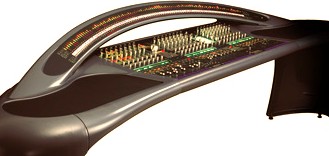
The above pic represented a new style of automated digital consoles, ergonomically designed for a single operator. A skilled operator could achieve the same outcome in a fraction of the time as the larger designs in the previous pic. Variations of these smaller designs evolved during the 1980s (over 20yrs ahead of their time).
DAW Digital Audio Workstations are todays replacment of the older generation of Large analogue mixing consuls, but many romantically argue these old consuls are superior in auditory performance to todays computerised mixing software.
Basic Principles
The first principal is to make the music come alive. This also means real, beginning with no effects, no EQ, no compression-limiting, simply relying on microphone technique, musician and instrument placement, and natural room reflections. Only from this initial starting position can the correct use of effects, EQ and compression-limiting enable one to create the desired outcome. This can be looked at in 3 parts.
1 Balance relation of loudness of each instrument and voice to each other.
2 Image pan positions (left - center - right) of each instrument and voice.
3 Dimension managed by EQ and effects, placing instruments and voices forward or back.
The following descriptions assume a basic background of using of mixers, EQ equalization, graphics, parametric, effects, microphones, leads connectors, power amplifiers and speakers.
Pop Recording
The traditional art of pop recording is to 'Construct the balance of a performance'. Reducing the dynamic range of the music, and compacting it with added effects, that enable it to sound acceptable on small, low fidelity domestic sound systems. The pic below is of a recording studio with small monitor speakers similar to many domestic sound systems.
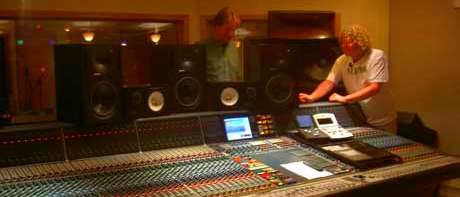
Recording today is as it was in the 1950s 1960s, compacting (compressing) the music to be heard best on small limited fidelity 4" to 8" speakers. Also constrained within the limited bandwidth of radio, TV, internet, and MP3. This requires the skilled use of effect processors.
- Frequency based - equalization, filters etc.
- Time based - delay, reverberation etc.
- Amplitude based - compression limiting, noise gates etc.

It is not possible for small, low fidelity domestic sound systems to replicate the full dynamic power of a real orchestra. Live music can have a dynamic power greater than 60dB (1 : 1,000,000).
The average domestic sound system may handle 20 Watts before it distorts. Approx 100 mW (1/10 Watt) is required to hear music at low level, depending on background ambient noise. The ratio of power difference between 1/10 Watt and 20 Watts is 1 : 200 (23 dB). The majority of recordings are compressed within 20 dB and many pop recordings compressed within 10 dB. 10 dB is an apparent loudness change of 1:2. And many remastered recordings are hyper-hyper-compressed to remove dynamic expression and range completely.
Phil Spector Wall of sound
Music of the 1950s and 60s was predominantly recorded to be heard on small portable record players and radiograms. The same size as domestic systems of today. With modern computers the recording technology has greatly improved but what it is used for has not changed. Today's small sound systems may have a slightly broader frequency response and more power, but the overall auditory experience is very similar. The beautifully restored Blaupunkt radiogram below could be argued as having superior fidelity than many of todays small sound systems.
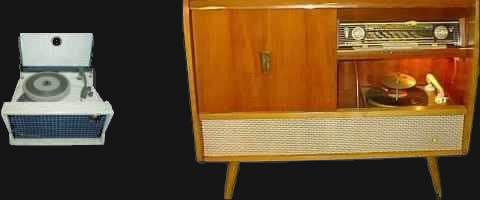
Phil Spector and the wall of sound is the name and term associated with pioneering production techniques (50s - 60s) giving a perception of a larger sound being experienced with small speakers. These production techniques also enabled maximum use of the limited dynamic range and bandwidth of AM radio transmission.
Google search on (Phil Spector) (Mowtown) (Recording history)
There are many examples of recorded music, live bands, TV and film sound that has been excellently produced with the correct use of compression and EQ. However little is said of pop mixing practices, especially the over use of compression that is destructive to the enjoyment of music. Please accept this criticism of the miss-use of excessive compression on behalf of all who are passionate of best practice.
The pop recording industry is dominated by trends, fads and brand names often with limited understanding of hardware technology, it is held back by 3 fundamental beliefs.
(a) Classical training or learning to read music will destroy my feel for playing pop.
(b) Basic technical knowledge of 'dB' and hardware is not required for mixing pop.
(c) The good sound knobs are Compression Compression
Compression
Many pop recording schools make money from young people supporting these beliefs. Playing with audio mixing computer packages and repeating jargon and brand names has become an education in itself including that 'compression' solves all problems and makes everything sound wonderful.
The Past Critical statements are often made about record companies failure to understand the digital revolution and the internet. Management practises based on short term thinking often have difficulty seeing opportunity's to transform their industries when new technology arrives. We must remember that record companies also strongly resisted the introduction to stereo recording during the 1950s.
Future opportunity The traditional over-compressed music for small speakers should be freely available over the internet. The irony is that by piracy it already is, reflecting its true value. Full dynamic minimally-compressed music arranged by different producers , as mixed stereo, or as original multi-tracks, should be available at an agreeable price. The opportunities created could be endless. With full fidelity active sound systems and advanced software for production mixing available to home users, the number of people participating could be magnitudes greater than it is today. The economic turnover would be an extension and similar to the computer games industry.
Live mixing
Young musicians and bands identify with iconic brand names (Fender Marshall etc) representing 1950s technology from the beginning of rock and roll, and very little has progressed since that time. It is essential for live music to progress past this 1950s approach and take advantage of modern technological management if it is to economically thrive.

The above pic is of a band comparing many different PA's. This traditional mixing approach is the same for domestic recording. The PA speakers are set up to represent a domestic sound system on a larger scale. Imposing the techniques of recording on a live production by constructing a separate compacted (compressed) mix to be heard on a poor fidelity and often distorted PAs, leads to the sound system competing with the performance. The result is often a cluttered mess which has little resemblance to how live musicians naturally sound up close without the PA.
This miss-use of technology which separates the audience from the performance has possibly contributed more to the downfall of live performances than all other problems combined.
The art of live mixing should be the opposite to traditional mixing for pop recording, e x p a n d i n g the expression of the music, bringing the performance forward into the audience. However, the musicians and artists must be in balance first. Bringing the performance forward with minimal change to the musical balance and with minimal use of effects, especially equalization and compression. This requires a greater discipline and understanding of
- Sound systems - speakers, amplifiers etc.
- Acoustics - room reverberation, critical-distance, directivity etc.
- Microphones - types, placement, direct and transmitting etc.
The first commandment of live mixing "Thou cannot equalise time with amplitude". As punishment thou shall be plagued with microphone feedback problems. Trying to compensate for bad acoustics and poor fidelity speaker systems with equalization is as silly as a dog chasing its tail.
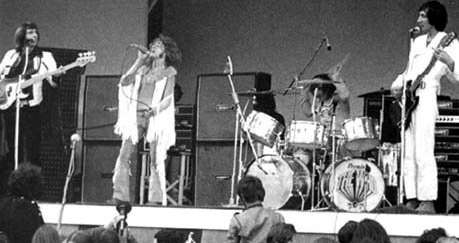
The above pic of The Who 1969 shows instrument amps and drums at front of stage. The audience could hear the band directly. These performances were often more energetic and louder than live bands today. This live approach of hearing the band directly only lasted a short time, approx 10 yrs. It was considered too difficult and complex to increase this method for large concerts, as in the pic below.
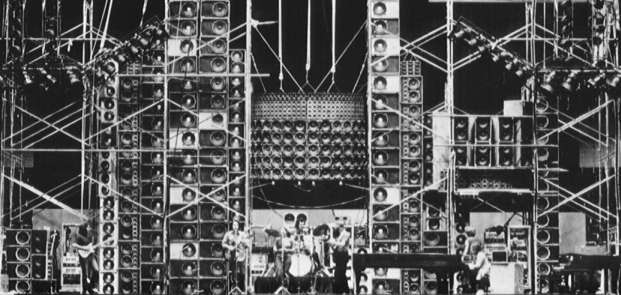
The above copyright pic on the Audio heritage web site is by the very kind permission of Richard Pechner www.rpechner.com
Click on the link above to see the 1970's The Grateful Dead sound system in full size on the Altec heritage site. This above approach had voice, instruments and percussion amplified and heard separately. This technique was more complicated and ahead of its time. However the emerging IT industry consumed the best technical people where they could earn 10 - 100 more than working in the entertainment industry. This is the primary reason this method did not become developed for live music production.
Future opportunity By the use of visual analogy the first step is to unlock the fixed psychological perception of a compressed mono mixed, often distorted sound. The grandeur of a large scale firework displays is used in the below pic to demonstrates this.

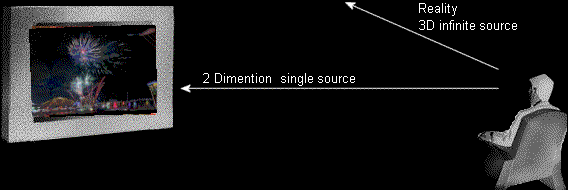
Watching a small mono video does not create the same experience for the observer as seeing the actual fireworks. When watching a video screen it is only the video screen that is being seen.
This may appear obvious, but it is strange that many people don't get this. The mind has to make an abstract interpretation of a video representing fireworks. The video screen is a flat 2D image at one point in space. The actual fireworks appear in 3D space from an infinite number of points.

Now we shall repeat the same example with music. Acoustically we hear a live orchestra as an infinite multitude of sound sources as a dynamic panoramic experience. When listening to a live performance through a low-fidelity PA system, mixed in mono and compressed, it is only the Left or Right speakers that are heard, not the actual live performance.
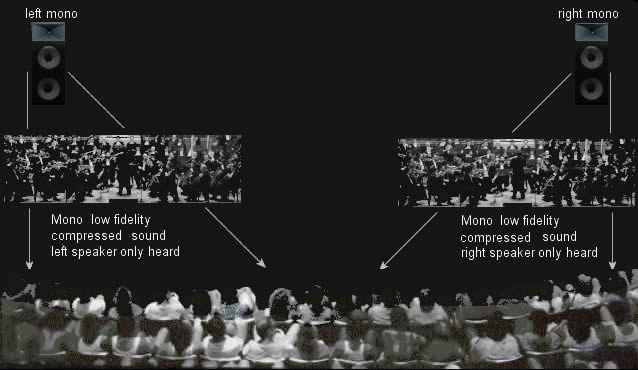
The audience only hear the speaker that is closest to them, and hear no center image or stereo depth of field. This is the same non-exciting experience as watching a video while pretending to imagine the fireworks. Also this is dual mono and not to be confused with stereo.
Stereo 3D sound dictionary definition adj: reproducer in which 2 microphones feed two or more loudspeakers to give a 3D three-dimensional effect to the sound. Stereo vision is 2 photographs taken from slightly different angles that appear three-dimensional when viewed together. Stereo is therefore the resultant 3D experience. Not to be confused with dual mono (left and right).
A multi channel 5 full-fidelity sound system can approximate a live orchestra, creating a virtual reality 3D experience for the audience. However, this is not the same as home cinema 5.1 which only has front 3 channels which the center channel dominates as mono. The aim is to enable the mixing process to be a transparent as possible. This means that the microphones appear to be directly connected to the speaker system. The sound system must be full fidelity with minimum to zero compression, for the 3D effect to be experienced.



5 channels can create 9 stereo fields from 5 speaker systems (AB) (AC) (AD) (BC) (BD) (CD). With a full fidelity active sound system each pair is able to function in full stereo to create a 3D panoramic depth of field. This can be increased to any number and is only limited by ones imagination and ability to manage the mixing complexity.
The microphones should appear to be connected directly to the amplifier speaker system, without the mixing process being apparent. This transparent mixing procedure will be discussed in more detail on the Microphones page.
The same experience can be created for a pop/jazz/rock production to enable the audience to experience the live music similar to being on stage with the musicians. This also requires a multi or quad sound system, based on full fidelity active technology. The production for live music should be separating the voices and instruments into an exciting wide panoramic spatial sound scape where the sound creation (not lighting) becomes the primary experience for live music.
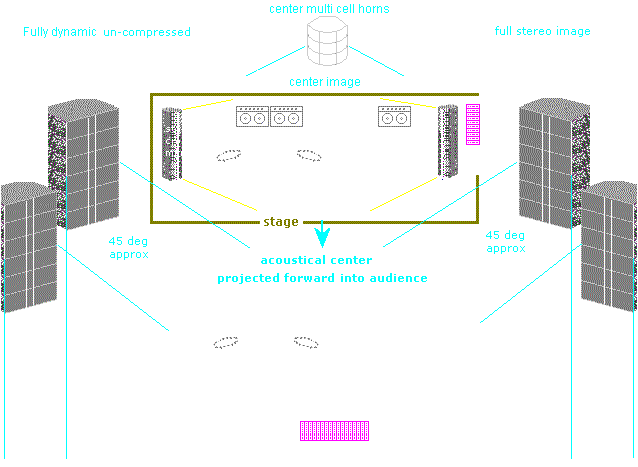
There are infinite variations on how this can be achieved. The variations should be tailored to each production. This approach has always been applied to lighting. With the assistance of digital management technology, now is the time for creative sound sculpturing to take center stage.
Cinema Sound
Mixing for cinema requires all previous skills. The objective is to match the sound with the moving image, enabling the picture to come alive. This requires sound to carry detail represented in the picture. If well done, the sound caries the moving image from 2 to 3 Dimensions. This effect is called Synesthesia.
Synesthesia is the experience we have when one sensory system effects another. A passing scent can evoke a strong memory, we can experience colours as warm-red or cold-blue. The music score and sound effects influence our feelings and how we experience seeing the picture. Synesthesia stems from the function of our imagination carrying sensory experience into altered states. Capturing one of our senses (sound) into 3D experience caries the other senses with it, giving the picture a larger 3D perception and enhance our enjoyment of the movie.
Approx 1 in 30 films are created by people who have this understanding and skill. The dialogue leads with visual form edited to the music score, 'Form following content'. This procedure is fully thought out in pre-production. Often the (left-center-right) speakers are utilised as a tri stereo field giving a full auditory depth of field to the picture.
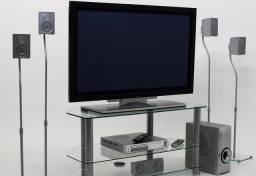
Unfortunately the majority of small 5.1 home cinema sound systems are of poor fidelity, causing the synesthesia effect to be limited or not possible. A large full-fidelity active stereo system will sound more realistic and swamp a small 5.1 system rendering it effectual. Also the small low fidelity domestic 5.1 systems have little in common with large commercial cinema sound systems.
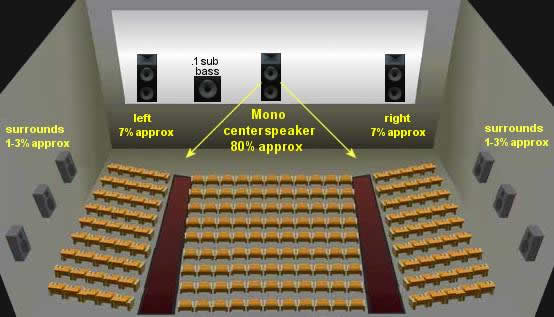
The Academy Characteristic is the standard protocol from early cinema history established in the late 1930s which included EQ per-emphasis to compensate for noise on film stock and the limited fidelity of cinema speakers. The standard also required the center speaker to carry the majority of the story information, without the need for left right and surrounds. Trapped by its history, cinema sound is fundamentally a mono format, which later added left right and surrounds. This regulation is not mandatory and mixing sound for cinema has always been add-hock.
www.filmsound.org is one of many excellent sites with historical information on cinema sound.
Many cinema complexes struggle to exist. A yearly average occupancy rate can be below 15%. Understandably many cinema complexes have little economic interest in supporting sound quality or surround sound formats, as they believe this has no influence on audience attendance. Through cost cutting one technician may have to look after many cinema complexes in a city region. The different audio formats which need to be checked for each film may be defaulted to the simplest system, or deferred to mono.
With all the good intentions the majority of films for the 12 to 25 yr old junk market are for short term cinema viewing before going to the video market. Many of these films are constructed with dialogue and music in a post production hotch-potched manner. The result is often a quasi mono compressed sound with disjointed periodic surround effects.
Dumbing down Regardless of how well a script is written, excessive dynamic compression makes the dialogue less intelligible and dramatically increases listening fatigue. Without clear un-compressed dialogue there can be no intellectual depth or meaning. The problem is made worse when the background music and sound effects are used to mask the dialogue, causing the sound to appear as a background wash behind the picture. This loss of intelligibility also forces the listener to interpret the dialogue. How often we sometimes need to play back repeatedly to understand a word or phrase. This miss-use of compression and noise masking to dumb-down films, is driven by ignorance and trend, not by educated understanding.
Future opportunity for cinema sound is when large scale digital projection becomes cost available and the historical Academy characteristic format that applied to celluloid film no longer applies. With digital projection the sound format can be open architecture similar to the future applications described above for live sound.
For home cinema the compression and EQ per-emphasis should now be encoded separately allowing the user to reduce or remove it on playback. Also digital management could allow the background music and sound effect levels to be adjusted separately from the dialogue. The denial of allowing this interactive management at the consumer level is a major limitation for home cinema.
Production Principles
The 3 Basic Rolls(1) Producer - Director. The Producer and Director roles are complementary and responsible for overseeing and managing everything. They maintain budget and time management and keep those who are paying the bills happy. They must have eyes and ears in every direction, and put out fires before they start. Their bible is 'How to win friends and influence people' by Dale Carnegie. For large productions there are sub managers responsible to the Producer and Director.
(2) Arranger - Conductor. The Arranger and Conductor roles are also complementary, for dotting the i's and crossing the t's of everything the artists and musicians do. They are responsible for each individual performance, and the production being fully rehearsed. They also have contingency plans for anything that can go wrong, ensuring the show go on.
(3) Engineer - Technician. The Engineer sits behind the mixing desk and takes direction from the Producer. The Engineer should have detailed knowledge of the hardware operation and its function. Sometimes the producer and engineer are the one schizophrenic person. The engineer must have the total detail of every channel's assignment and settings for each session including microphone placement and software filing.
The Engineer must have the ability to accurately anticipate what the Producer requires, and achieve it instantly. The Engineer also must have the unique ability to be non-judgemental of any music or insane demand from the producer or musicians. The best engineers evolve from technicians that have a musical or engineering background in acoustics or electronics. Technicians are responsible to the engineer and are responsible for studio calibration, maintenance and performance of all equipment.
In small productions, the roles of Production, Arranging, and Engineering can be managed by the musicians. Regardless of who is responsible for the 3 roles, each role must be in place.
Education
The correct procedure for learning mixing engineering and producing is in a training studio. Small groups of students (approx 5) first learn to repeatedly assemble and disassemble all equipment in the studio. This is the only way for students to understand where everything is, and the order in which it functions.
- At the completion of each practical learning exercise (approx 3 hours), the studio is stripped of all leads and interconnects and neatly put back on to racks.
- Microphones and accessories are carefully inspected and cleaned and put back into their boxes and signed off, accounting for all stock.
- The mixing console and effects have all knobs and switches returned to default positions.
- Each students or trainee maintains their log books, computer files, mixing sheets. All paper work is cross checked that everything is up to date and accounted for.
1 - Studio language 2 - Studio function 3 - Flow charts 4 - Acoustics 5 - Mic techniques 6 - Effects 7 - Monitoring systems 8 - Musical Instruments 9 - Live Production 10 - Studio design
Procedures for learning to mix are similar to learning to drive a car (attention - attention - attention). Mixing can be learnt in stages similar to musicians practicing scales. Once learnt, the mechanical process becomes automatic (unconscious). These steps are often omitted in text books and rarely taught in questionable audio schools.
Success principles
(A) Excellence 'A commitment to completion'.
Everyone be excellent at what they do; the percussionist an excellent percussionist, the keyboard player an excellent keyboard player, the producer an excellent producer etc. A variation of this principle is that everyone be at the same level. It is not possible for a production to succeed (in the long term) if individuals are at different levels of professionalism, limited by the weakest link.
(B) Prompt 'Timing is everything'.
Each individual is responsible for, attending rehearsals on time, being at the venue on time, performing in time. Stress and anxiety cease when everyone is prompt. The production becomes magic.
(C) Consideration 'Each person considers others first'.
Therefore everyone is looking after each other. The production is the center, free of individual ego. This only comes into being when everyone considers the others feelings first, including the audience. This includes 'Passion' the ultimate love for music and audience.
A production that is successful (in the long term) has all 3 principles in place. 'there is no exception'.
Other web sites that have excellent information on mixing.
Please give yourself the time to read these pages and go to the links listed on them.
Articles on mixing and compression
www.cdmasteringservices.com/dynamicrange.htm
www.georgegraham.com/compress.html
www.soundonsound terms glossary
www.soundonsound mixing articles
www.ranecommercial.com/legacy/library
www.behringer.com/downloads
www.tweakheadz.com
Companies products and organisations
www.filmsound.org
www.rane.com
www.dolby.com
www.dbxpro.com
http://www.mackie.com
www.allen-heath.com
www.soundcraft.com


